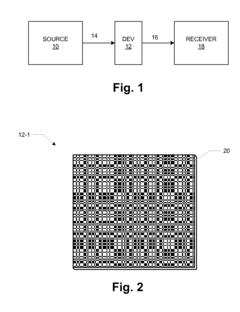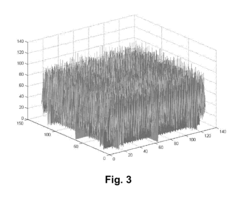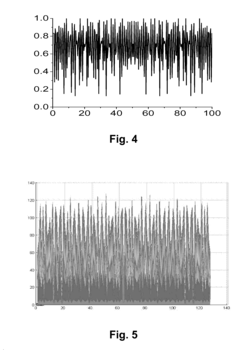How to Apply Quasicrystal in Energy Harvesting Systems?
Quasicrystal Energy Harvesting Background
Quasicrystals, discovered in 1982 by Dan Shechtman, represent a unique class of materials that exhibit long-range order but lack periodicity. This distinctive structural characteristic has sparked significant interest in their potential applications, particularly in the field of energy harvesting. The concept of utilizing quasicrystals for energy harvesting systems has emerged as a promising avenue for addressing the growing global demand for sustainable energy solutions.
The background of quasicrystal energy harvesting is rooted in the material's exceptional properties, which include low thermal and electrical conductivity, high hardness, and low friction coefficients. These attributes make quasicrystals particularly attractive for thermoelectric applications, where the conversion of temperature differences into electrical energy is paramount. The unique atomic arrangement in quasicrystals creates a complex electronic structure that can potentially enhance the Seebeck effect, a key phenomenon in thermoelectric energy conversion.
Research into quasicrystal-based energy harvesting systems gained momentum in the early 2000s, with initial studies focusing on the thermoelectric properties of Al-Cu-Fe and Al-Pd-Mn quasicrystalline alloys. These investigations revealed that quasicrystals could exhibit higher thermoelectric figures of merit compared to their crystalline counterparts, primarily due to their intrinsically low thermal conductivity and potentially high electrical conductivity when properly doped.
The application of quasicrystals in energy harvesting extends beyond thermoelectric devices. Their unique surface properties, characterized by low adhesion and friction, have led to explorations in tribological energy harvesting, where mechanical energy from friction and wear can be converted into useful electrical energy. This approach holds promise for recovering energy in various mechanical systems, from automotive applications to industrial machinery.
Moreover, the photonic properties of quasicrystals have attracted attention for potential use in photovoltaic systems. The aperiodic nature of quasicrystalline structures can create photonic band gaps and localized optical modes, which could enhance light trapping and absorption in solar cells, potentially improving their efficiency.
As research in this field progresses, scientists and engineers are exploring novel synthesis methods and compositional variations to optimize quasicrystals for specific energy harvesting applications. The interdisciplinary nature of this research, combining materials science, physics, and engineering, underscores the complexity and potential of quasicrystal-based energy harvesting systems.
Market Analysis for Quasicrystal Energy Systems
The market for quasicrystal energy harvesting systems is emerging as a promising frontier in the renewable energy sector. As global energy demands continue to rise and the need for sustainable solutions becomes more pressing, quasicrystals offer unique properties that could revolutionize energy harvesting technologies. The market potential for these systems spans across various industries, including aerospace, automotive, consumer electronics, and industrial applications.
Current market analysis indicates a growing interest in quasicrystal-based energy harvesting solutions, driven by their ability to capture and convert energy from multiple sources simultaneously. This versatility positions quasicrystal systems as a compelling alternative to traditional energy harvesting methods, potentially addressing the limitations of existing technologies in efficiency and adaptability.
The automotive sector presents a significant market opportunity for quasicrystal energy systems. With the increasing adoption of electric and hybrid vehicles, there is a rising demand for innovative energy recovery solutions. Quasicrystal-based systems could be integrated into vehicle designs to harvest energy from vibrations, heat, and electromagnetic fields, potentially extending the range and efficiency of electric vehicles.
In the aerospace industry, weight reduction and energy efficiency are critical factors. Quasicrystal energy harvesting systems offer the potential to create lightweight, multifunctional materials that can generate power from various environmental stimuli during flight. This could lead to reduced fuel consumption and increased operational efficiency for aircraft.
The consumer electronics market also shows promise for quasicrystal energy harvesting applications. As wearable devices and Internet of Things (IoT) technologies proliferate, there is a growing need for self-powered systems. Quasicrystal-based energy harvesters could potentially extend battery life or even eliminate the need for batteries in certain low-power devices, opening up new design possibilities and improving user experience.
Industrial applications represent another significant market segment for quasicrystal energy systems. In manufacturing and process industries, these systems could be employed to recover waste heat, vibrations, and other forms of energy typically lost during operations. This could lead to improved energy efficiency and reduced operational costs for industrial facilities.
While the market for quasicrystal energy harvesting systems is still in its early stages, industry analysts project substantial growth potential in the coming years. The increasing focus on sustainability and energy efficiency across various sectors is expected to drive demand for innovative energy solutions, positioning quasicrystal-based systems as a key technology in the future energy landscape.
Quasicrystal Technology Status and Challenges
Quasicrystals, discovered in 1982 by Dan Shechtman, represent a unique class of materials that exhibit long-range order but lack periodicity. Their application in energy harvesting systems is an emerging field that holds significant promise, yet faces several technological challenges. Currently, the development of quasicrystal-based energy harvesting systems is in its early stages, with research primarily focused on theoretical modeling and small-scale experimental demonstrations.
The primary challenge in applying quasicrystals to energy harvesting lies in the complexity of their structure and the difficulty in manufacturing large, high-quality samples. Unlike conventional crystalline materials, quasicrystals lack translational symmetry, making their production and characterization more challenging. This structural complexity, while potentially beneficial for energy harvesting applications, presents significant obstacles in terms of material synthesis and device fabrication.
Another major hurdle is the limited understanding of quasicrystals' physical properties in the context of energy harvesting. While their unique electronic and phononic properties suggest potential advantages in thermoelectric and photovoltaic applications, translating these theoretical benefits into practical devices remains a significant challenge. Researchers are still working to fully comprehend how the quasiperiodic structure influences energy conversion efficiency and how to optimize these materials for specific energy harvesting applications.
The integration of quasicrystals into existing energy harvesting technologies also presents technical difficulties. Most current energy harvesting systems are designed around conventional materials, and incorporating quasicrystals often requires redesigning entire device architectures. This integration challenge is compounded by the need for new manufacturing processes and quality control methods tailored to quasicrystalline materials.
Despite these challenges, progress is being made in several key areas. Researchers have demonstrated promising results in using quasicrystals for thermoelectric applications, leveraging their low thermal conductivity and potentially high electrical conductivity. Additionally, investigations into photonic quasicrystals for light harvesting have shown potential for enhancing the efficiency of solar cells.
The geographical distribution of quasicrystal research and development is primarily concentrated in advanced research institutions across North America, Europe, and East Asia. However, the field remains relatively niche, with a limited number of specialized research groups worldwide focusing on the application of quasicrystals in energy harvesting.
In conclusion, while the application of quasicrystals in energy harvesting systems shows great potential, significant technological challenges must be overcome. These include improving manufacturing processes, enhancing our understanding of quasicrystal properties in energy conversion contexts, and developing new device architectures. As research progresses, overcoming these hurdles could lead to innovative and highly efficient energy harvesting solutions.
Current Quasicrystal Energy Harvesting Solutions
01 Quasicrystal structures for energy harvesting
Quasicrystal structures are utilized in energy harvesting devices due to their unique atomic arrangements and electronic properties. These structures can enhance the efficiency of energy conversion processes, particularly in thermoelectric and photovoltaic applications. The non-periodic yet ordered nature of quasicrystals allows for novel energy band structures that can be exploited for improved energy harvesting performance.- Quasicrystal structures for energy harvesting: Quasicrystal structures can be utilized in energy harvesting devices due to their unique atomic arrangements and properties. These structures can enhance the efficiency of energy conversion processes, particularly in thermoelectric and photovoltaic applications. The aperiodic nature of quasicrystals can lead to improved electron and phonon transport properties, potentially increasing the overall energy harvesting capabilities.
- Electromagnetic energy harvesting using quasicrystal-based devices: Quasicrystal-based devices can be designed to harvest electromagnetic energy from various sources. These devices may incorporate quasicrystal structures to enhance the capture and conversion of electromagnetic waves into usable electrical energy. The unique properties of quasicrystals, such as their high electrical conductivity and low thermal conductivity, make them suitable for electromagnetic energy harvesting applications.
- Quasicrystal-enhanced thermoelectric energy harvesting: Quasicrystals can be incorporated into thermoelectric materials to improve their energy harvesting capabilities. The complex atomic structure of quasicrystals can lead to enhanced phonon scattering, which may result in reduced thermal conductivity while maintaining good electrical conductivity. This combination of properties can potentially increase the thermoelectric figure of merit, leading to more efficient energy harvesting from temperature gradients.
- Quasicrystal-based photovoltaic energy harvesting: Quasicrystal structures can be utilized in photovoltaic devices to enhance light absorption and energy conversion efficiency. The unique optical properties of quasicrystals, such as their ability to exhibit photonic band gaps and localized optical modes, can be exploited to improve light trapping and electron-hole pair generation in solar cells. This approach may lead to more efficient harvesting of solar energy.
- Integration of quasicrystals in energy harvesting systems: Quasicrystals can be integrated into various energy harvesting systems to improve overall performance and efficiency. This may include incorporating quasicrystal structures into energy storage devices, such as batteries or supercapacitors, or using them in hybrid energy harvesting systems that combine multiple energy sources. The unique properties of quasicrystals can potentially enhance energy conversion, storage, and distribution in these integrated systems.
02 Wireless power transfer using quasicrystal metamaterials
Quasicrystal-based metamaterials are employed in wireless power transfer systems to improve efficiency and range. These materials can be designed to manipulate electromagnetic fields in ways that enhance power transmission and reception. The unique properties of quasicrystals allow for the creation of novel antenna designs and resonant structures that optimize wireless energy transfer.Expand Specific Solutions03 Quasicrystal-enhanced thermoelectric devices
Thermoelectric devices incorporating quasicrystalline materials demonstrate improved energy conversion efficiency. The complex atomic structure of quasicrystals can lead to low thermal conductivity while maintaining good electrical conductivity, which is ideal for thermoelectric applications. These materials are used to develop more efficient heat-to-electricity conversion systems for waste heat recovery and power generation.Expand Specific Solutions04 Quasicrystal-based photovoltaic cells
Photovoltaic cells utilizing quasicrystalline structures show enhanced light absorption and charge carrier transport properties. The unique electronic band structure of quasicrystals can be exploited to create intermediate bands or multiple exciton generation, potentially increasing the efficiency of solar energy conversion. These novel photovoltaic designs aim to surpass the theoretical limits of conventional solar cells.Expand Specific Solutions05 Energy harvesting from mechanical vibrations using quasicrystals
Quasicrystalline materials are incorporated into mechanical energy harvesting devices to convert vibrations into electrical energy more efficiently. The unique elastic properties and phonon band structures of quasicrystals can enhance the conversion of mechanical energy from various sources such as industrial machinery, vehicles, or human motion. These systems aim to provide sustainable power for sensors and low-power electronic devices.Expand Specific Solutions
Key Players in Quasicrystal Energy Industry
The application of quasicrystals in energy harvesting systems is an emerging field in the early stages of development. The market size is relatively small but growing, driven by increasing demand for efficient energy solutions. The technology's maturity is still evolving, with research institutions like Massachusetts Institute of Technology, The Johns Hopkins University, and University of Rochester leading fundamental studies. Companies such as Infineon Technologies AG and Texas Instruments Incorporated are exploring practical applications. Universities in China, including Southeast University and Xi'an Jiaotong University, are also contributing significantly to the field. While the technology shows promise, it requires further development to achieve commercial viability and widespread adoption in energy harvesting systems.
Infineon Technologies AG
Taiwan Semiconductor Manufacturing Co., Ltd.
Core Innovations in Quasicrystal Energy Technology
- The use of quasi-crystalline materials, either as a homogeneous layer or as a component in inhomogeneous materials, with a volume fraction exceeding 30% and specific elemental compositions, combined with dielectric matrices or substrates, to achieve desired optical properties and stability.
- A method for extending deterministic, aperiodic structures into two and three dimensions using sequences like Rudin-Shapiro, Thue-Morse, and Fibonacci, with deterministic patterning and inflation rules to achieve multi-dimensional equivalents of one-dimensional spectral responses, enabling control of light localization and field enhancement effects.
Environmental Impact of Quasicrystal Energy Systems
The environmental impact of quasicrystal energy systems is a crucial aspect to consider as this innovative technology advances. Quasicrystals, with their unique atomic structures and properties, offer potential benefits in energy harvesting applications while also presenting certain environmental considerations.
One of the primary environmental advantages of quasicrystal-based energy systems is their potential for improved energy efficiency. The distinctive structural properties of quasicrystals can lead to enhanced thermoelectric performance, potentially reducing energy waste in various applications. This increased efficiency could contribute to overall energy conservation and reduced greenhouse gas emissions associated with power generation.
However, the production and manufacturing processes of quasicrystals may have environmental implications. The synthesis of quasicrystals often involves complex procedures and the use of rare or specialized materials. The extraction and processing of these materials could potentially lead to environmental concerns such as resource depletion, habitat disruption, or increased energy consumption during production.
The durability and longevity of quasicrystal-based energy systems may positively impact their environmental footprint. If these systems prove to be more resilient and longer-lasting than conventional alternatives, it could reduce the need for frequent replacements and minimize waste generation over time. This aspect aligns with sustainable design principles and circular economy concepts.
Recycling and end-of-life management of quasicrystal energy systems are important considerations. The unique composition of quasicrystals may present challenges in terms of material recovery and recycling processes. Developing efficient recycling techniques for these materials will be crucial to minimize environmental impact and promote resource conservation.
The potential for quasicrystal energy systems to enable more widespread adoption of renewable energy technologies is another significant environmental factor. If these systems can enhance the performance and efficiency of solar panels, wind turbines, or other renewable energy devices, it could accelerate the transition to cleaner energy sources and reduce reliance on fossil fuels.
Water usage and potential contamination are additional environmental aspects to evaluate. Depending on the specific applications and manufacturing processes of quasicrystal energy systems, there may be implications for water resources that need to be carefully managed and mitigated.
As research and development in this field progress, it will be essential to conduct comprehensive life cycle assessments of quasicrystal energy systems. These assessments should consider all stages from raw material extraction to end-of-life disposal, providing a holistic view of the environmental impacts and benefits associated with this technology.
Scalability of Quasicrystal Energy Harvesting
The scalability of quasicrystal energy harvesting systems presents both opportunities and challenges for widespread implementation. As research progresses, the potential for scaling up these systems to meet larger energy demands becomes increasingly feasible. One of the key advantages of quasicrystal-based energy harvesters is their ability to capture energy across a broad spectrum of frequencies, making them adaptable to various environmental conditions and energy sources.
The manufacturing processes for quasicrystals are continually improving, allowing for the production of larger and more complex structures. This advancement is crucial for scaling up energy harvesting capabilities. As production techniques become more refined, the cost-effectiveness of manufacturing larger quasicrystal arrays increases, making them more viable for commercial applications.
Modular design approaches are being explored to enhance scalability. By creating standardized quasicrystal units that can be easily combined, researchers aim to develop systems that can be scaled up or down depending on energy requirements. This modularity not only facilitates easier installation and maintenance but also allows for gradual expansion of energy harvesting capacity as needed.
Integration with existing energy infrastructure is another important aspect of scalability. Researchers are investigating ways to incorporate quasicrystal energy harvesters into buildings, vehicles, and other structures without significant modifications to current designs. This integration could lead to widespread adoption in urban environments and transportation systems.
However, challenges remain in scaling quasicrystal energy harvesting systems. The efficiency of energy conversion at larger scales needs to be carefully studied and optimized. Additionally, the long-term stability and durability of scaled-up systems must be ensured to make them viable for sustained energy production.
As the technology matures, the potential for large-scale quasicrystal energy harvesting becomes more realistic. From small personal devices to expansive energy farms, the scalability of these systems could revolutionize how we capture and utilize ambient energy. Continued research and development in this field are essential to unlock the full potential of quasicrystal-based energy harvesting on a global scale.




